Table of Contents[Hide][Show]
Contributed by our friend Paul Turner with TakeOutdoors.com
It is so important for all of us to use natural products as much as we can. When products absorb into our skin it is so important that the products we use are natural.
The skin is the largest organ on the body and it will absorb everything and anything that can fit through the pores.
Many products that come into contact with the skin like, beauty products and cleaning products, contain hundreds of toxic chemicals and additives that can be harmful to the body.
Hundreds of toxic chemicals used in products sold in supermarkets and stores everywhere are known to cause growth abnormalities and can absorb into the body 3 times quicker than water can.
So, it only takes a limited amount of contact with a toxic product for it to be absorbed into your bloodstream. Scary, isn’t it?
Way too scary!
One of the most toxic kinds of products available to buy is insect repellent which commonly uses many toxic chemicals in order to keep the bugs away.
The problem is, whilst it’s scaring the bugs away it is also doing scary things in your body.
The Issue with DEET
DEET is a prime example of harmful insect repellents. DEET is exceptionally effective, but it is absolutely packed with chemicals.
A study conducted on DEET in the 1980’s on workers based in a National Park using the product found that a massive 25% of those involved in the study experienced negative health effects.
Those negative health effects including horrible symptoms like rashes, burning lips, sickness, headaches and dizzy spells. Further studies conducted on animals have shown that prolonged DEET use can lead to brain cell death and changes in behavior.
Clearly opting for a more natural product to keep those pesky bugs away is a good idea for our bodies, but you can’t guarantee 100% natural ingredients in a product labelled as natural in a shop.
Unfortunately marketing law accepts that if a product has as little as 10% natural products inside it, even if that is alongside a ton of other chemicals, it can be labelled as natural.
The Benefits of Going Natural
The best choice for your health is to make your own bug spray, which is also much more likely to be environmentally friendly too.
After all chemicals that we use in the air and on ourselves can just as easily get absorbed into the atmosphere, water sources, the ground and into wildlife, flora and fauna.
Another great thing about making your own bug spray from essential oils is that you can customize the ingredients to suit your needs.
Different essential oils offer different things:
- Catnip—Relaxation, strong insect repellent
- Cedar wood—Calming, insect repellent
- Citronella—Strong insect repellent
- Clove—Temporary dental pain relief, snake repellant
- Geranium—Hydrates skin, insect repellent
- Lavender—Calming, soothing, mosquito repellent
- Lemon Eucalyptus—Enhances mood, insect repellent
- Patchouli—Rejuvenates skin, insect repellent
- Peppermint—Cooling, helps bad breath, spider repellant
- Rosemary—Hair treatment, insect repellant
- Tea tree—Helps calm, insect repellent
- Vetiver—Relaxing, mosquito repellent
In this article, we’re going to make sure you make the most effective natural bug spray around, so you’re fending off the nasty without putting any nasties into your body.
Can You Blend Any Essential Oil?
We are not ones to hinder creativity and self-expression!
You can mix any oils you want to, but there are a few considerations to make to ensure your concoction is as sensible and safe as possible:
Phototoxicity
Certain essential oils cause your skin to be more sensitive to the sun causing burning, blistering and other unwanted symptoms.
So it makes sense not to use these kinds of oil in a product like insect repellent which you may spray on your skin before being out in the sun.
A good rule of thumb is to stay away from citrus in the sun, but you can find a good list of phototoxic essential oils here.
Diluting is Important
Too much essential oil could irritate the skin so your mixture should definitely be diluted. As oil and water don’t mix, you’ll need to mix with a carrier oil such as liquid coconut oil or almond oil.
The recommended ratio is 1 drop of essential oil to 1 TBSP of carrier oil.
Allergies Should be Noted
If you mix together a repellent blend that causes allergic reactions in those using it, you should take note so that you can avoid using the same blend again.
Extra Ingredients can Bring Benefits
There are certain extra ingredients you could add that will bring some great benefits.
Witch hazel, for example, is a natural preservative and it can be really help for blemish prone skin.
Apple cider vinegar is another great addition for natural bug spray because it has tons of benefits like restoring natural PH balance, clearing dead skin and adding beta carotene.
Consider How You are Using it
Some insect repellents can be used as diffusers where they are misted into the air around where you are sitting.
Some insect repellents are misted on the skin so that you repel insects wherever you go. If you are diffusing you don’t need to dilute the solution quite as much, and you can be a bit more gung-ho about your combinations.
When the product will be going onto the skin you’ll want to think more carefully about the properties of the oil.
Are Essential Oils Suitable for Children and Pregnancy?
There are articles out there that mention certain oils are alright to apply topically on the skin for kids under 2 years old and when pregnant.
However, I highly encourage you to only use the oil if your child is at least 3 months old or you are in your second trimester. This is because the neonatal skin is particularly delicate.
Also! Remember to dilute your essential oil first.
Below is the list of essential oils, what bugs do they repel and whether it is safe for kids or for pregnancy.
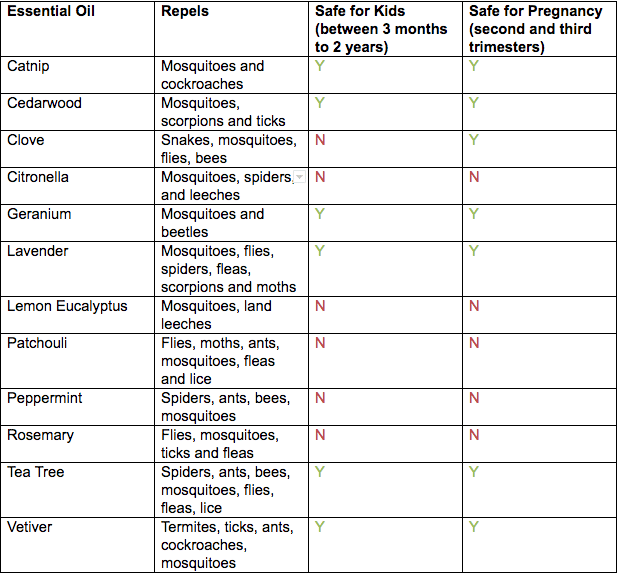
Start mixing
Bubble Bubble, toil and trouble it is time to make your potion! No need for tail of newt or ear of bats in this mix though, just plenty of beautiful essential oils and all natural ingredients to keep those naughty insects away!
Of course, there are plenty of bug spray combinations that you can try and experiment with, but we have these three recipes for you to make so you’ve got natural bug repellent at your fingertips straight away.
1—Homemade Citronella Bug Spray
Ingredients
2 Ounces of either pure vodka, witch hazel or apple cider vinegar
2 Ounces of filtered water or spring water
16 drops of citronella essential oil
10 drops of geranium essential oil
16 drops of cedar wood essential oil
22 Ounces of almond or coconut oil (for topical use)
Directions
Begin by adding your essential oils to the vinegar, vodka or witch hazel and allow it all to sit for five minutes before stirring.
Then add the water and pour the whole mix into a glass spray bottle.
If this is for applying on to skin, you might want to dilute it.
You might also want to add a sticky label onto the bottle listing the ingredients, or note them down.
2—Vanilla & Peppermint Bug Spray
Ingredients
1 Cup of vodka
1 TBSP of cloves
1 TBSP vanilla extract
1 TBSP peppermint essential oil
Directions
Combine all of the ingredients together and allow to steep overnight. Pour the whole mix into a glass spray bottle.
You might also want to add a sticky label onto the bottle listing the ingredients, or note them down.
Note: This is a very concentrated bug spray so please do not apply directly on to your skin.
3—Essential Oil Bugs Away Mix
Ingredients
¼ of a cup of witch hazel
¼ TBSP liquid vegetable glycerin
5 Drops of rosemary essential oil
5 Drops of citronella essential oil
5 Drops of lavender essential oil
5 Drops of clove essential oil
5 Drops of peppermint essential oil
5 Drops of eucalyptus essential oil
15 Ounces of almond or coconut oil (for topical use)
¼ Cup of filtered water or spring water
Directions
Combine the witch hazel, essential oils and vegetable glycerin. Allow to sit for five minutes before mixing.
Then pour into a glass spray bottle.
You might also want to add a sticky label onto the bottle listing the ingredients, or note them down.
Again, if you want to apply on to your skin, do dilute it with other carrier oils.
Natural bug spray: Avoiding nasties like bugs and chemicals
Essential oils have lots of benefits but it is really important to use them safely.
Do be careful with avoiding phototoxic essential oils if you plan to use the mix on your skin.
You should also always do 24-hour patch tests when using mixes on sensitive skin.
When spraying you will also need to be careful to avoid spraying the mix into your eyes.
If you do happen to get oil in your eyes, place a carrier oil like vegetable or coconut oil onto a clean paper towel and wipe the eye then repeat as necessary.
If at any point, you are concerned about a reaction or essential oil exposure, get to the nearest emergency room for help.
Natural bug spray is a cinch to make, and is just as effective as the expensive and chemical-laden alternative. Once you’ve got the hang of mixing, there’s no doubt you’ll be making your own sweet scented concoctions to keep your whole family free of nasty bug bites.
Author Bio:
Paul Turner is the man behind TakeOutdoors.com, which he shares all his knowledge and experiences on camping. He has also developed a camping checklist generator that allows you to customize your camping checklist.
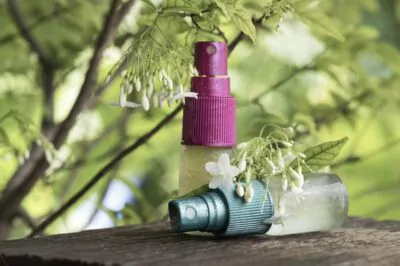

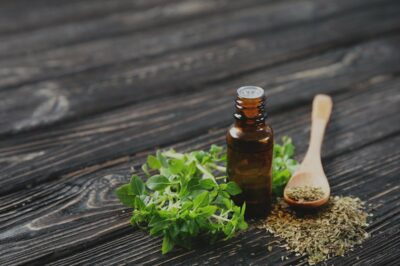
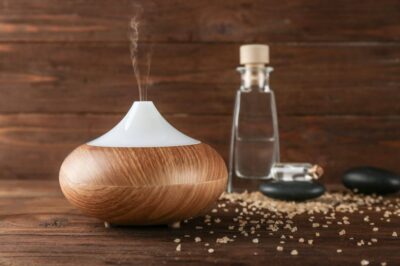
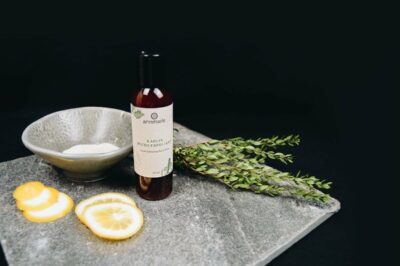
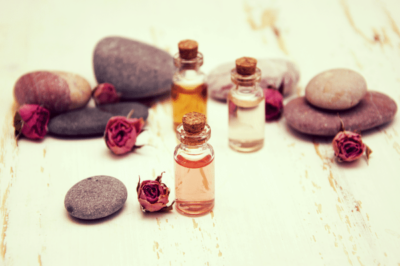
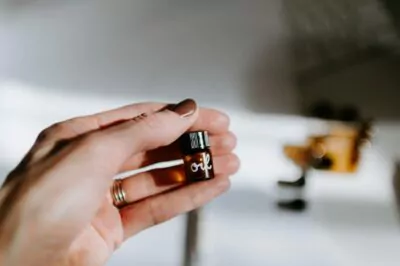
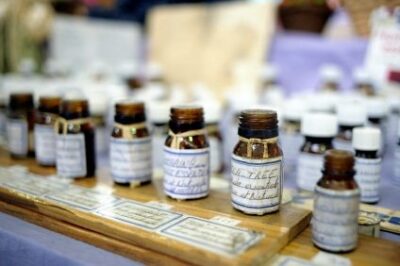
Leave a Reply